The Juan de Fuca Ridge and its Flanks
In 2002, a team from the Lamont-Doherty EarthObservatory, Woods Hole Oceanographic Institution, and Scripps Institution of Oceanography conducted an extensive MCS investigation of the Juan de Fuca Ridge (JdFR) and its flanks. The goals were (1) to characterize the structure of the JdFR, including the location of axial magma chambers (AMC), and relate these observations to the recent eruptive history of the ridge and morphological indicators of magmatic state; (2) to measure variations in velocity and thickness of the shallowest crust at the ridge axis; and (3) to characterizethe evolution of the upper crust as a function of sedimentation history, crustal age, and basement relief to provide constraints on crustal alteration and ridge-flank fluid circulation.
Our study revealed magma bodies beneath all JdFR segments (including those previously assumed to be in a tectonic phase) and a close association between the presence and dimensions of the axial summit graben and the presence of an AMC. We infer that the axial rift relief is generated by magmatic rather than tectonic processes. The topographic characteristics of the JdFR segments, the distribution of melt lenses, and the differences in Moho depth among segments reveal a recent history of ridge-hotspot interaction since ~0.6 Ma associated with the Cobb hotspot at Axial volcano and the Heckel melt anomaly at Endeavour segment, as well as the influence of absolute plate motion of the JdFR on mantle melting and melt distribution beneath the ridge axis.
We found that all of the known hydrothermal fields in the Endeavour segment sit above an AMC at 1.7-2.9 km depth, suggesting that hydrothermal circulation at this intermediate-spreading segment is driven by magmatic processes. At the southern JdFR, variations in layer 2A thickness suggest that processes of lava emplacement and distribution may be modulated by changes in axial morphology due to small fluctuations in magma supply that have a significant impact on the axial thermal structure. AMC physical properties (Vp and strength of P-to-S conversions at the AMC) vary along the Cleft segment, indicating changes in crystallinity that correlate with lava chemistry and the location of hydrothermal plumes. The data revealed a complex, asymmetric set of melt sills beneath Axial volcano at shallow depths (>1350 m), which might suggest a decoupling of hotspot-related melt supply and the overriding plate.
Upper crustal structure on the ridge flanks shows a clear correlation between sediment burial, crustal age, and upper crustal velocities. Along sedimented flanks, seismic layer 2A acquires the properties of mature crust observed globally in less than 10 Myr, while at least 16 Myr of crustal evolution is needed for complete maturation of the upper crust along the sparsely sedimented or sediment barred flanks. This pattern is attributed to more rapid precipitation of minerals in the upper crust as the hydrothermal regime evolves from open exchange with the water column to a regime closed to seawater exchange. Moho was imaged through much of the survey area, including sub-Moho reflection events that may correspond to frozen magma sills emplaced at the base of the crust during ridge propagation.
This study also revealed the presence of a near-axis lower crustal melt sill, providing evidence for the existence of low permeabiity barriers to melt migration within the lower oceanic crust.
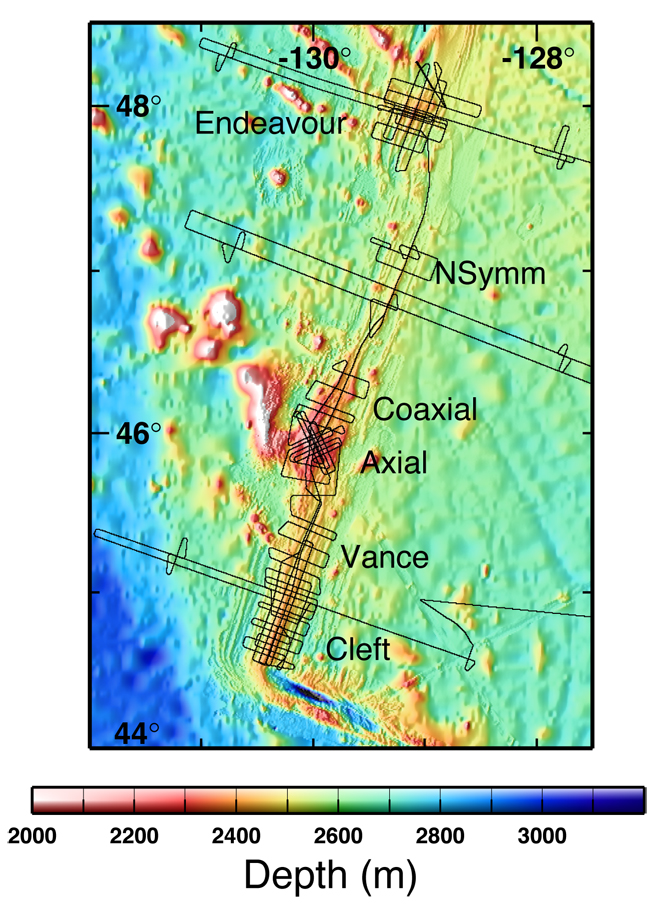
Regional bathymetry for Juan de Fuca Ridge and track of seismic survey EW-0207. (Carbotte et al. [2006])
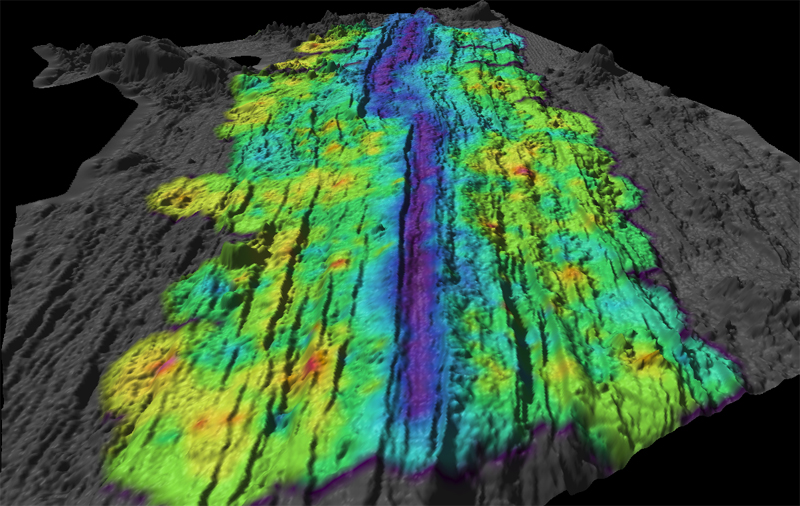
Three dimensional perspective of seismic layer 2A thickness map draped over the bathymetry of Cleft segment.
(Canales et al. [2005])
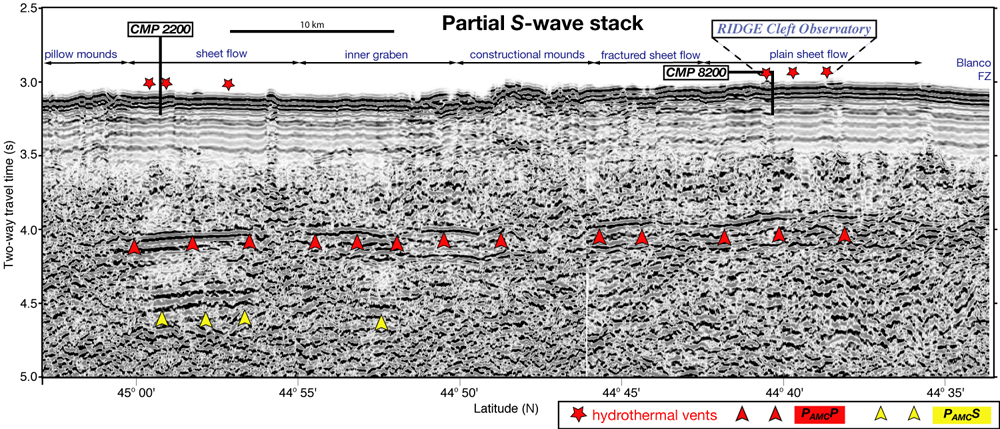
Partial-offset S-wave stack along the axis of the Cleft segment, showing the PAMCP and PAMCS events.
(Canales et al. [2006])
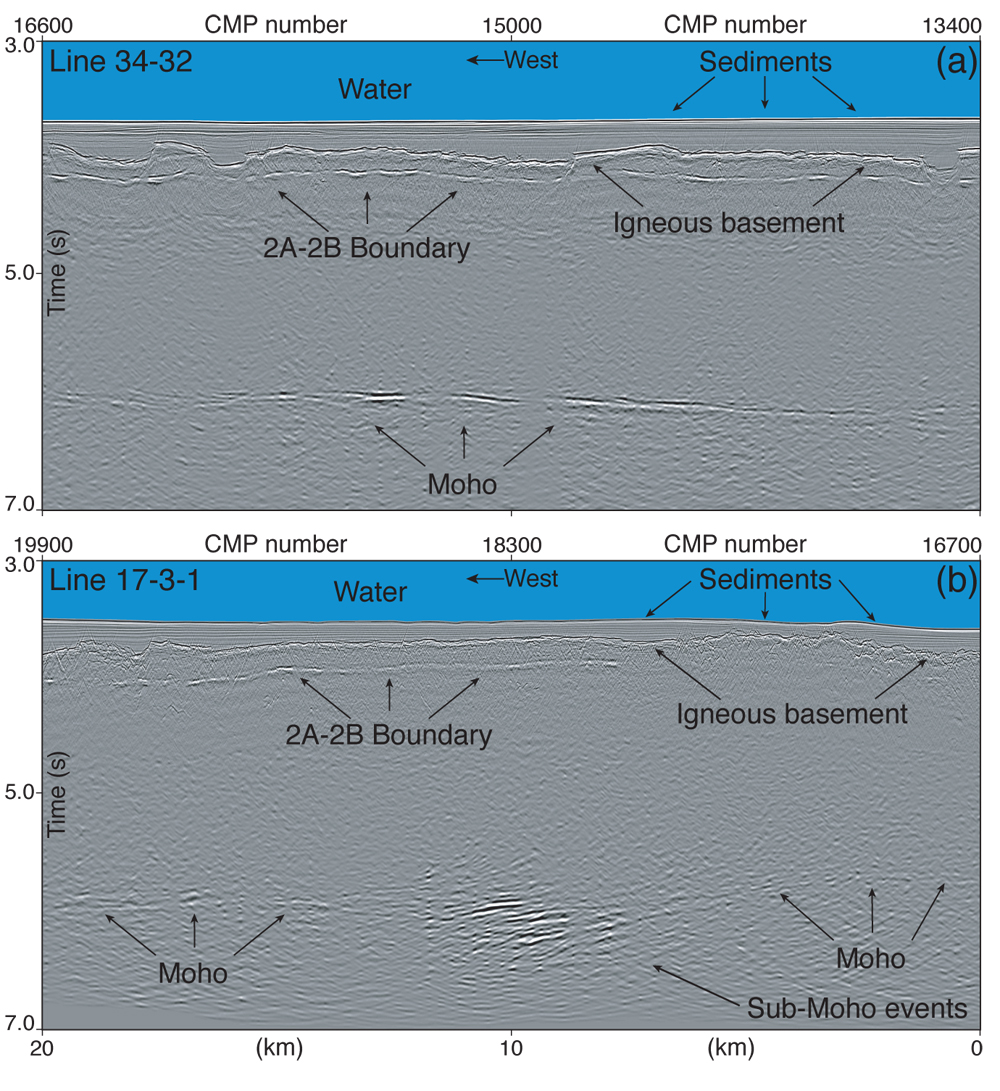
Two 20 km-long sections along the eastern flank of the JdFR: Part (a) is characterized by a mostly continuous and sharp image of the igneous basement surface, the layer 2A/2B boundary and the Moho discontinuity. Part (b) shows all the same events as part (a) but differs from it because it also includes a set of sub-Moho reflections.
(Nedimovic et al. [2005])
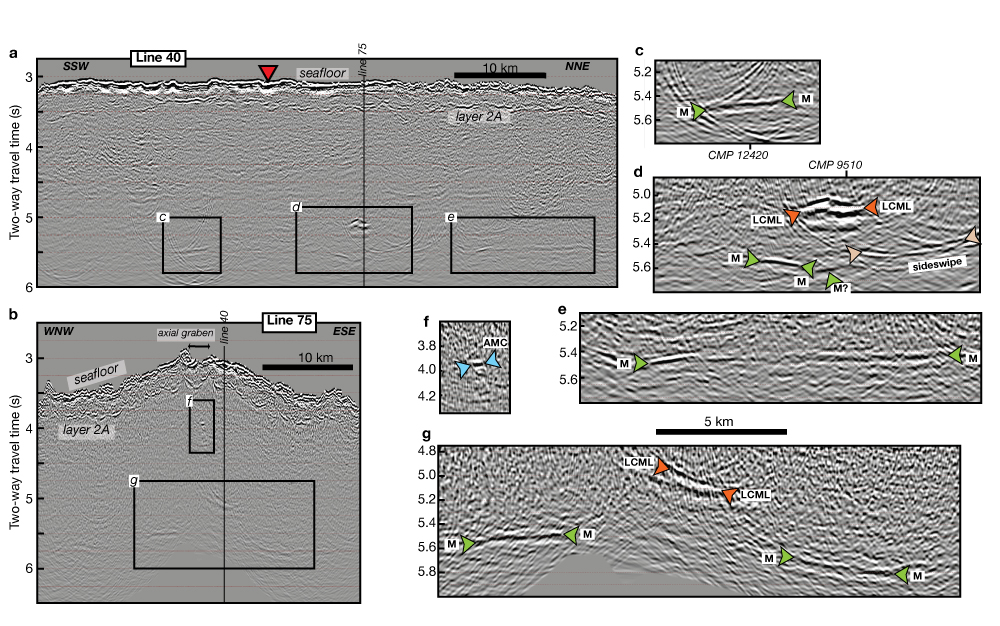
Migratedseismic reflection profiles 40 and 75. a. Ridge-parallel profile 40, located3.3 km to the east of the spreading axis. Vertical line locates the intersection with profile 75. Boxes enclose parts of the profile shown in detail in c, d, and e. Red triangle locates low-temperature hydrothermal vents observed on the seafloor30. b. Ridge-perpendicularprofile 75. Vertical line locates the intersection with profile 40. Spreading axis is within the labelled axial graben. Boxes enclose parts of the profile shown in detail in f and g. Main events are indicated with colour arrows: top of axial magma chamber (AMC),lower crustal melt sill (LCML), and Moho (M). Vertical axes are two-way travel time in seconds for all panels. Scale bar in the middle is for panels c-g. Locations of CMP 12420 and 9510 are labelled in c and d, respectively. The event labelled as sideswipe in d is interpreted as such based on its steep hyperbolic diffraction character observed in the stacked image, as well as in its higher frequency content relative to the lower-frequency, flat-lying Mohoevents.
Collaborators
Robert Detrick (WHOI)
Suzanne Carbotte and John Diebold (LDEO)
Mladen Nedimović (Dalhousie University)
Graham Kent, Alistair Harding, and Jeff Babcock (SIO)
Satish Singh (IPGP-CNRS)
Related Links
Data from this project are available to the public through the Marine Seismic Data Center .
Publications arising from this research:
Arnulf, A.F., A.J. Harding, G.M. Kent, S.M. Carbotte, J.P. Canales, and M.R. Nedimović (2014), Anatomy of an active submarine volcano, Geology, 42, 655-658.
Canales, J. P., R. S. Detrick, S. M.Carbotte, G. M. Kent, J. B. Diebold, A. J. Harding, J. Babcock, M. R. Nedimović, and E. van Ark (2005), Upper crustal structure and axial topography at intermediate-spreading ridges: seismic constraints from the Southern Juan de Fuca Ridge, J. Geophys. Res., B12104, doi:12110.11029/12005JB003630.
Canales, J. P., S. C. Singh, R. S. Detrick, S. M. Carbotte, A. J. Harding, G. M. Kent, J. B. Diebold, J. Babcock, and M. R. Nedimović (2006), Seismic evidence for variations in axial magma chamber properties along the southern Juan de Fuca Ridge, Earth Planet. Sci. Lett., 246, 353-366.
Canales, J. P., M. R. Nedimović, G. M. Kent, S. M.Carbotte, and R. S. Detrick (2009) Seismic reflection images of a near-axis melt sill within the lower crust at the Juan de Fuca Ridge, Nature, 460, 7251, 89-93.
Carbotte, S. M., R. S. Detrick, A. J. Harding, J. P. Canales, J. Babcock, G. M. Kent, E.van Ark, M. R. Nedimović, and J. B. Diebold (2006), Rift topography linked to magmatism at the intermediate spreading Juan de Fuca Ridge, Geology, 34, 209-212.
Carbotte, S. M., M. R. Nedimović, J. P. Canales, G. M. Kent, A. J. Harding, and M. Marjanović (2008), Variable crustal structure along the Juan de Fuca Ridge: influence of on-axis hotspots and absolute plate motions, Geochem., Geophys., Geosyst., 9, Q08001, doi:08010.01029/02007GC001922.
Marjanović, M., S. M. Carbotte, M. R. Nedimović, and J.P. Canales, Gravity and seismic study of crustal structure along the Juan de Fuca Ridge axis and across pseudofaults on the ridge flanks (2011), Geochem., Geophys., Geosyst., 12, Q05008.
Nedimović, M. R., D.R. Bohnenstiehl, S. M. Carbotte, J. P. Canales, and R. P. Dziak (2009), Faulting and hydration of the Juan de Fuca plate system, Earth Planet. Sci. Lett. 284, 94-102.
Nedimović, M. R., S. M. Carbotte, J. B. Diebold, A. J. Harding, J. P. Canales, and G. M. Kent (2008), Upper crustal evolution across the Juan de Fuca Ridge flanks, Geochem., Geophys., Geosyst., 9, Q09006, doi:09010.01029/02008GC002085.
Nedimović, M. R., S. M. Carbotte, A. J. Harding, R. S. Detrick, J. P. Canales, J. B.Diebold, G. M. Kent, M. Tischer, and J. Babcock (2005), Frozen magma lenses below the oceanic crust, Nature,1149-1152.
Newman, K.R., M. R. Nedimović, J.P. Canales, and S. M. Carbotte, Evolution of seismic layer 2B across the Juan de Fuca Ridge from hydrophone streamer 2D traveltime tomography (2011), Geochem., Geophys., Geosyst., 12, Q05009.
Van Ark, E., et al. (2007), Seismic structure of the Endeavour segment, Juan de Fuca Ridge: Correlations with seismicity and hydrothermal activity, J. Geophys. Res., 112, B02401, doi:02410.01029/02005JB004210.
